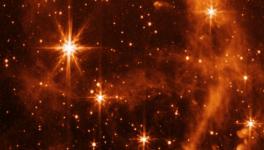James Webb Telescope Spots Carbon Dioxide in Distant Exoplanet

Representational use only. Image Source: Flickr.
Recently, the James Webb Telescope has been in focus for another important finding: the presence of carbon dioxide in a distant exoplanet. Experts opine that it could herald a new era of research on outside-the-solar-system worlds.
The finding of carbon dioxide came during Webb’s first campaign focusing on exoplanets. This aimed at a giant hot and gaseous planetary object named the WASP-39b, located at a distance of 700 light-years from Earth and in the constellation Virgo. Notably, this planet is equally massive as Saturn but it is larger than the Jupiter. Again, this was earlier observed by the Hubble Space Telescope and also by the Spitzer Space Telescope.
The James Webb observatory’s main focus is on infrared wavelengths carrying heat. Interestingly, the Spitzer Space Telescope also observed the heat carrying infrared wavelengths. Previously, the presence of water vapour, sodium, and potassium could be observed in the atmosphere of the planet. But for the first time, James Webb could detect the presence of carbon dioxide in it.
Zafar Rustamkulov, a graduate student at Johns Hopkins University, USA, a member of the exoplanet team, and a co-author of the preprint paper claiming the presence of carbon dioxide commented in a statement—“As soon as the data appeared on my screen, the whopping carbon dioxide feature grabbed me. It was a special moment, crossing an important threshold in exoplanet sciences.” Notably, carbon dioxide has not been detected in exoplanets before this. However, astronomers think that carbon dioxide can help them better understand the formation history and also the evolution of the exoplanets. The discovery of carbon dioxide was made using the NIRSpec instrument of the Webb.
Regarding this, Laura Kreidberg, the director of the Max Planck Institute for Astronomy in Germany and also a co-author of the preprint paper was quoted as saying, "This unequivocal detection of carbon dioxide is a major milestone for exoplanet atmosphere characterisation. Carbon dioxide helps us measure the complete carbon and oxygen inventory of the atmosphere, which is highly sensitive to the conditions in the disk where the planet formed."
"These measurements can help identify how far from its star the exoplanet was formed and also determine the amount of solid and gaseous material it accumulated while it migrated to its current location," she added.
The researchers believe that James Webb will be able to make them detect carbon dioxide in other exoplanets as well. They also think that Webb will be able to detect carbon dioxide in Earth-like rocky bodies that are scattered in the galaxy. The exoplanet WASP-39 b is orbiting its parent star WASP-39 very closely which will be equal to 1/20th distance between Earth and the Sun.
The James Webb Telescope was launched into space to find the light emanating from the early universe’s first galaxies by exploring the solar system and the exoplanets—the planets that orbit stars other than the Sun. A primary target of the observatory will be the epoch where the early pioneering stars whose light ended the darkness theorised to engulf the cosmos shortly after the Big Bang happened, a time of more than 13 billion years ago.
One of the first success of the observatory was the images captured by it that reveals far-distant galaxies as they were some 4.6 billion years ago. These images were considered to be compelling and also thought that they are the first step toward reshaping our understanding of the time when the universe dawned.
Get the latest reports & analysis with people's perspective on Protests, movements & deep analytical videos, discussions of the current affairs in your Telegram app. Subscribe to NewsClick's Telegram channel & get Real-Time updates on stories, as they get published on our website.
























